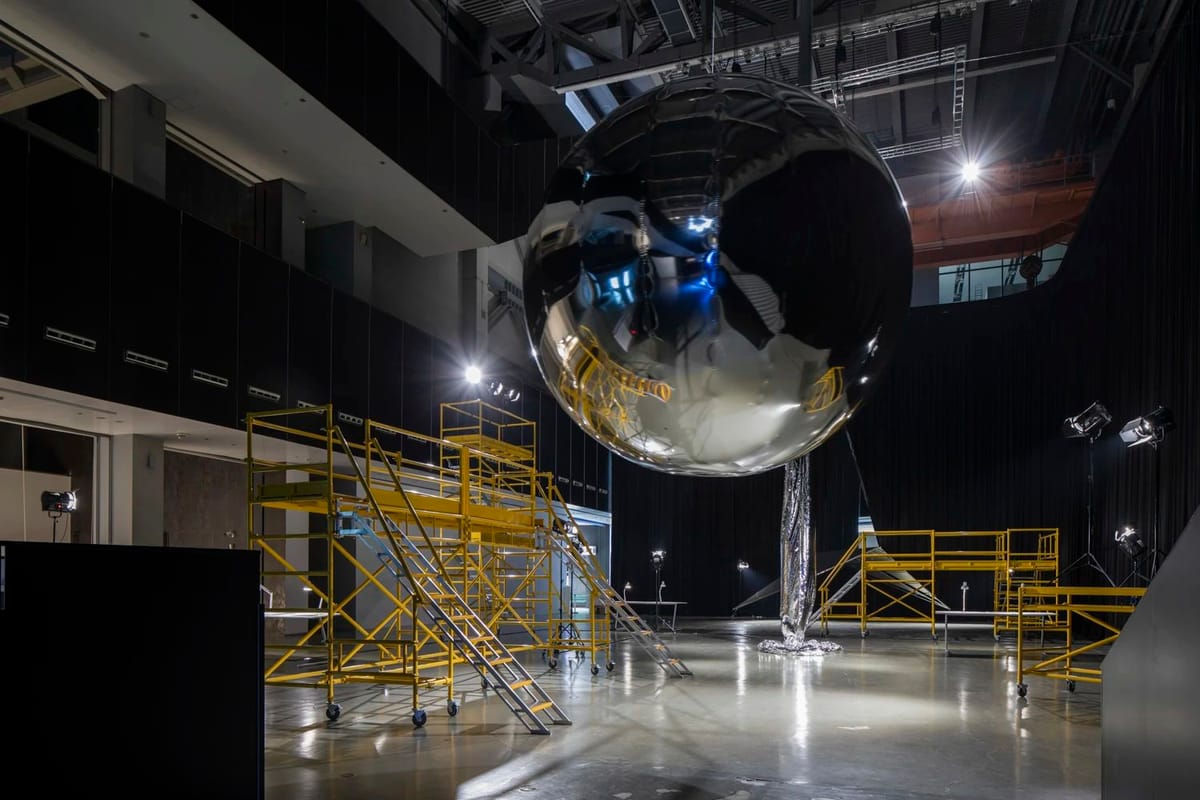
The Shanghai Biennale was initiated in 1996 and is the first international biennial of contemporary art on the Chinese mainland. The 14th biennale opened on 9 November 2023 at the Power Station of Art in Shanghai, which is the first state-run museum dedicated to contemporary art in mainland China. Selected artists for this edition of the biennale include Black Quantum Futurism, Saodat Ismailova, Deimantas Narkevičius, Agnieszka Polska, Raqs Media Collective, Kidlat Tahimik and others.
Anton Vidokle is chief curator of the Shanghai Biennale and co-founder of e-flux. Lukas Brasiskis is a curator on the artistic team of the Shanghai Biennale and also curator of film and video at e-flux. Additional curators on the artistic team of the biennale include Zairong Xiang, Hallie Ayres and Ben Eastham. We spoke to Anton and Lukas by email about their work organizing the 14th Shanghai Biennale, which has the title Cosmos Cinema and is presented in a multilayered dialogue with all things cosmological. This interview has been edited for length and clarity.
Anton, how does the philosophy of Cosmism relate to the theme of the biennale?
Vidokle: Cosmism is something I have been researching for more than a decade: through making films, publications, symposia, etc. This is the first opportunity we have for a large scale exhibition that touches on this topic. I would not call the biennale a specifically “Cosmist” exhibition, although certain ideas of Nikolai Fedorov and particularly Alexander Svyatogor were very central to our thinking about various aspects of the exhibition. Over all, it’s broader than what is normally considered “Cosmism” in the sense of a Russian philosophy, or is a kind of an expanded cosmism that includes related developments in other cultures, civilizations and eras.
Let me explain: Similarly to how we have been thinking about cinema pre-existing the invention of the camera, according to Alexander Kluge, who writes that cinema is a cosmic phenomenon of flicker of light that carries information about past, present and even the future, Cosmism is also something that arguably existed as long as humans have been aware of death, had a desire for immortal life and resurrection, and a sense of wonder about stars and planets we see in the night sky. These are not merely Western, Christian desires – it is also the center of Daoism, which has to do with internal alchemy: through diet, a certain lifestyle and spiritual growth one aspires to develop an immortal embryo within oneself that will go on to live forever. The first emperor of China, emperor Chin, made immortality his life’s goal. Ironically he may have died as a result of this having poisoned himself with mercury, which was thought to be an elixir for eternal life. Or you can think about Mesopotamia and the epic of Gilgamesh – another king who dedicated himself to achieving immortality. In most ancestral cults, which are the true religion according to Nikolai Fedorov, the ancestors live in the stars or are stars. So all these ideas of eternal life, resurrection and life in the cosmos, they are as old as human civilization.
Above all else, we tried to explore an idea that cosmos is not something distant and abstract, but is right here on Earth, a part of our everyday life. And not only in the technological sense, but in terms of all aspects of social life: agriculture and economy, medicine, spirituality and religion, social relations and organization, architecture, and so forth. The show tries to touch on all of this through works of artists from many different parts of the world over a span of about a hundred years. As broad as this is, it is just a sliver of the enormous cultural layer one can explore trans-historically and transnationally in relation to this subject.
It is rare that a visual art biennale includes the word “cinema” in its organising theme and is referenced so heavily in its concept. Can you speak more about how the medium of cinema figures in the exhibition?
Vidokle: I am not a curator, but more of an artist and filmmaker. So when we started thinking about how to approach organizing this biennale, I realized that the methodology of filmmaking – montage, editing and so forth – all these are very powerful tools to organize a complex exhibition that encompasses many works, languages, ideas, forms and experiences. What we really hoped for is that it could be possible to produce a kind of a cinematic space in an art exhibition rather than a museographic type of space. I always felt that museography often flattens works of art, reduces the experience to mere contemplation rather than a more active psychological encounter one sometimes has with film. So it was interesting to try to develop an exhibition as a kind of a dialectical immersive space that engages emotions, psychology, etc., a magical space where one can get lost, disoriented and transformed to some extent, like a film. Hopefully some of this comes through in this show.

The exhibition is organized into multiple thematic clusters that you call "palaces." Can you speak more about the decision to use this dense constellation of ideas to structure the show?
Vidokle: In Chinese cosmology there is a very interesting notion of the nine palaces. In short this has to do with the flow of the cosmic energy - qi. The palaces are modular, essential elements that can be rearranged to improve the flow of this energy. You move through them physically and spiritually. This is also the principle on which Feng Shui is based, which has to do with manipulation of this invisible force or energy flow. We tried to think of the show as a kind of a cosmos in itself that is made up of these nine thematic palaces, which the audience can move through to create their own syntax, meaning and experience of the exhibition.
What are some of your personal highlights in the show, or what would you like to draw specific attention to?
Vidokle: Oh that’s an unfair question : ) Every work in the show was selected for very specific reasons and is a highlight of something particular. Maybe for me it was just really special to be able to bring paintings and drawings from the Kostakis Collection at the Greek State Museum in Thessaloniki. This is the largest collection of the Soviet avant-garde outside Russia, and avant-garde works have never been exhibited in Shanghai, so it was really important historically to be able to present them at the biennale.

Lukas, you are curator of film and video at e-flux. What was your specific area or division of responsibilities in organizing the biennale?
Brasiskis: The curatorial team worked very closely, ensuring we were all partaking in the main decisions. Yet, we had clear divisions too. As a curator of film, I was extremely happy to receive Anton’s invitation to join the curatorial team of the biennale with such a theme. Obviously I focused more on moving image art, including overseeing some artists' video installations as well as the Solaristics room, which explores the tensions between Stanislaw Lem's novel Solaris and its film adaptations.
My main responsibility however was the curation of the Cosmos Cinema educational film program. This program aims to integrate the history of cinema into the Biennale, offering weekly on-site screenings and lectures at the Power Station of Art in Shanghai, as well as an online platform oriented to global audiences. In addition, my academic background in cinema studies, for instance my interest in the early theories of film time, informed and shaped our discussions, helping us to conceptualize different connections between cinema and cosmos, with an emphasis on cinema's power to present a decentralized and localized view of the world as cosmos.
What were some of the unique qualities and challenges in organising a show at the Power Station of Art in Shanghai?
Brasiskis: The Power Station of Art space, with its unique architecture and post-industrial character, posed challenges and presented amazing opportunities as we conceptualized the exhibition like a film. Working together with the amazing architects Collective Studio, and the talented designers Non-Place Studio, through the design and architecture of the exhibition we sought to mirror the experiential quality of an open-form film that leaves room for the visitors’ imagination and interpretation. For example, there are numerous instances where visitors encounter the same artworks multiple times from different perspectives, akin to a film montage of non-linear temporality with its flashforwards and flashbacks. This would be hard to imagine working so well in another space.

What type of public programming can we look forward to as the biennale unfolds over time? In particular, can you tell us more about the online platform that was developed for your moving image programs.
Brasiskis: The biennale will have a series of public lectures related to both cosmos and cinema. We will also launch a catalogue edited by Ben Eastham, presenting a number of specially commissioned texts on these topics. And yes, we have also developed the special website cosmoscinema.art to supplement our weekly Cosmos Cinema educational film program taking place in Shanghai. This online platform aims to be a convergence point where histories of cinema, unearthed in the Power Station of Art screenings, meet the moving image works of contemporary artists installed in the biennale’s main exhibition.
Aligning with the biennale's nine thematic sections or palaces, each week features a selected online screening of a work by one of the biennale artists, accompanied by relevant contextual information. The Cosmos Cinema website will showcase works by various artists including: Itziar Barrio, Yin-Ju Chen, Saodat Ismailova, Deimantas Narkevičius, Liu Xin, Maha Maamoun, Agnieszka Polska, Raqs Media Collective, Ho Rui An, Xu Bing, Liu Yujia, He Zike, Julieta Aranda, Jakub Štourač and Anna Lunakova, and Zhou Xiaohu, among others. We envisioned it as a portal for those who can't visit Shanghai to experience these works that are installed in the exhibition.
Thank you!

